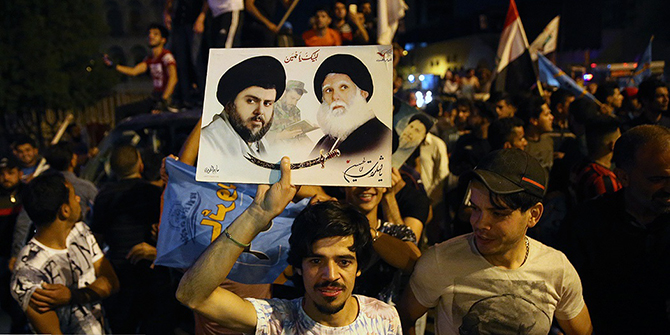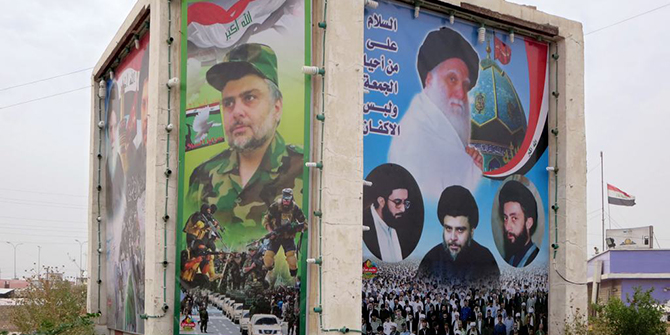by Toby Dodge
This memo was presented at a workshop organised by the LSE Middle East Centre on 29 June 2018 looking at the comparative politics of sub-state identity in the Middle East.

If the study of sectarian mobilisation is both driven and constrained by the polarisation of rationalist individualism and collective structuralism, then applying insights from Pierre Bourdieu’s work may well help to gain greater understanding about the move from the banal social recognition of religious difference to assertive and divisive political sectarianism.
Bourdieu described his own working method as ‘constructivist structuralism’. By this he meant his work certainly identified causative structures beyond the consciousness of agents, that agent’s perceptions have a ‘social genesis’. However, he also wanted to reintroduce the role of agency that structuralism had sought to abolish, to make people’s actions more than the outcome of obeying rules. Bourdieu himself wrote on ethnic and religious identity. He stressed that the solidification of ethnic (and in the Middle East religious) identities during political mobilisation was the outcome of competitive struggles over social classification, that it was those who managed to control the most symbolic and material power who dictated which social categories came to dominate at any given moment.
At the core of Bourdieu’s working method and crucial to the examination of sectarian mobilisation in the Middle East are a number of key concepts, habitus, field, various forms of capital and the central notions of symbolic power and symbolic violence. The deployment of this method can fruitfully shed light upon why sectarian mobilisation has become widespread. Under Bourdieu’s influence, this can be done without succumbing to an explanation that prioritises either structure or agency to the exclusion of the other.
Every modern society becomes divided into a number of specific spaces for competition, which Bourdieu labels as fields. These fields are differentiated from each other by the nature of the competitors and the struggle they are engaged in. For example, the struggle for Iraqi identities after 2003 was primarily conducted within Iraq’s political field.
Those fighting with each other for dominance within fields seek to accumulate and deploy capital to win their struggle. There are four main types of capital. The first and most obvious is economic capital, money and property rights. The second is social capital. This amounts to social networks and obligations, the ability to organise and mobilise, the benefits that come from group membership. The third type is cultural capital. This can be objectified in material objects like paintings, books and furniture, but it can also be institutionalised in educational qualifications or embodied in an individual’s bearing, her language capabilities or scholarly and religious learning.
Most importantly for both his work and the explanation of sectarianism in the Middle East, Bourdieu identifies symbolic capital and symbolic violence as the most powerful ways through which individual perceptions and then social order are shaped. Symbolic violence draws distinctions and establishes hierarchies between different groups, for example religious ones, removing empirical fluidity. The struggle to gain symbolic power, to impose symbolic violence, is the competition to structure the common sense operating in any given political field.
A central focus for Bourdieu’s work is both the political field and the state. The political field, like all fields, is an arena in which people and groups amass symbolic capital in the competition to impose their own vision as the dominant common sense. However, struggles within the political field, conducted by politicians, have a larger aim beyond the field itself, to define the social world in its totality. Bourdieu labels these competing definitions of the social, ‘principles of vision and division’. These, in the hands of competing politicians, start off as ‘speculative ideas’ only to harden into powerful positions through their ability to be adopted by, and hence mobilise, people. The political field has a powerful role within any society, a role of censorship, of ‘limiting the universe of political discourse’, of placing boundaries on what is politically thinkable. It is within Iraq’s political field post-2003 that a dominant principle vision was imposed and reshaped peoples’ habitus. This new common sense, imposed by politicians, restructured the social world, stressing communalist identities, Shi’a, Sunni and Kurd, to the exclusion of much else.
For Bourdieu, common sense is structured around the process of classification, the division and ordering of the social world through the imposition of categories and their naming. This is how agents gain their perception of the social world that they live in and are allocated the groups they become members of and hence their identities.
According to Bourdieu, it is primarily within Iraq’s political field that the political identities of individual Iraqis are shaped. Tracing the rise of sectarianism within Iraq’s political field would involve identifying and explaining the rise to dominance of sub-state communalist ‘principles of vision and division’, that ‘limit the universe of political discourse’.
From the invasion by a US-led coalition in March 2003, Iraq’s political field became internationalised. The US formally occupied the country until 28 April 2004, when it handed ‘sovereignty’ back to a hand-picked group of Iraq politicians. It then exercised its influence through a series of powerful ambassadors, with a large number of civilian and military staff. During this time, America’s ability to wield economic capital was greater than any other competitor in the political field, having spent $200 billion on reconstruction alone. Although exercised in a less formal way, a number of regional states, foremost among them Iran, also deployed symbolic power and coercive and economic capital in an attempt to impose their own principle visions on Iraq’s political field.
The Iraqi state after 2003 closely resembles Bourdieu’s understanding of the state as a disaggregated ‘ensemble of fields that are the site of struggles’. In April 2003, the civilian capacity of the state was dismantled by the looting that spread across Baghdad. 17 of Baghdad’s 23 ministry buildings were completely gutted. In addition, the US occupying authorities, obsessed with the potential threat of reconstituted authoritarianism, disbanded the armed forces and intelligence services and purged the civil service of the top four levels of the Ba’ath party’s membership, while banning any party member occupying the top three management levels of any government institution. In addition, they set about dividing the ministries with coercive capital between different political parties, deliberately setting up fields of competition within each ministry.
Other memos in the series:
- ‘Seeking to Explain Sectarian Mobilisation in the Middle East’ by Toby Dodge
- ‘Tracing the Rise of Sectarianism in Iraq after 2003’ by Toby Dodge
- ‘Identity and State Formation in Multi-Sectarian MENA Societies: Relations between Nationalism and Sectarianism’ by Raymond Hinnebusch
- ‘Beyond the Spectre of Sectarianism: The Case of Tunisia’ by Teije Hidde Donker
- ‘Ontologies of Sectarian Identity: The Many Layers of Sunni–Shi’a Relations’ by Fanar Haddad
- ‘Studying sectarianism while beating dead horses and searching for third ways’ by Morten Valbjørn






